 by Eladrin
by EladrinHi everyone!
I hope your summers have been going well! I got a bit sunburnt, but today we’re back and ready to talk about some of the promising experimentation we’ve been doing with the Habitat system.
We’ll be going through the entire development process in this dev diary, so there’s going to be a lot of ideas that were interesting but were subsequently discarded for various reasons.
Why Are You Looking at Habitats Again? The Stellaris Custodian team looks to three primary categories when deciding what to pursue:
- Directives: Things dictated by me, the Game Director, usually for long term strategic reasons.
- Community: Things you ask for. Pain points, quality of life improvements, bug fixing, and other good ideas from the community.
- Passion: Things the individual developers really want to do.
Conveniently, a lot of times all of these align quite nicely.
Let’s start by looking at the history of Habitats in Stellaris.
Habitats were introduced way back in the 1.5 ‘Banks’ update in
Utopia.
In 2.3 ‘Wolfe’, alongside
Ancient Relics, we removed the Voidborne requirement to build Habitats, adjusted their habitability a little bit, and gave them varying districts based on what they were built over.
The 2.7 ‘Wells’ patch made the next major change to Habitats, adjusting their costs, requirements, and adding multiple tiers.
Since then, we’ve added a couple of special Habitat variants, and various other reworks have shifted their fortunes up and down in the overall balance of the game. Recently, there have been many requests from the community to review the tendency of AI empires building dozens of Habitats when they’re otherwise unable to expand.
Due to how production and population work in Stellaris, this led to an interesting quandary - it is theoretically “correct” for the AI to create many Habitats if it was blocked in, but it was tedious as a player to deal with invading up to a dozen Habitats per system. (The current interactions with population growth have also always been troublesome on the game balance side.)
Habitats were feeling far too common, were too good at certain things, and weren’t capturing the base fantasy that we were looking for. They’re the central pillar of a very popular playstyle that we wanted to preserve, though, so this made them a perfect target for “summer experimentation”.
Everything in this dev diary is considered experimental, and may or may not make it live.All numbers are placeholders for prototyping purposes only. There is no set release date for any of these changes at this time, but we welcome community feedback. Different Takes One of the most common requests from the Community was to add a Galaxy slider to restrict the use of Habitats. Options could have ranged from banning Habitats entirely, to “Nobody (except Void Dwellers) can create Habitats”, requiring the Ascension Perk to build them again, restricting only the AI, or placing (hard or soft) limits to the number of Habitats that could be built.
We also discussed “what if Habitats cost fractional Starbase Capacity to build” - with Void Dwellers and the Voidborne AP granting discounts to this value. This was more appealing, since the soft cap would control AI use of Habitats nicely without significantly hindering players that wanted to go all-in on them.
These discussions led to some questioning about whether Stellaris Habitats were satisfying the general fantasy well enough, and whether Habitats should be more “hard sci-fi”, with lower habitability bases or even ceilings for those accustomed to planetbound life, and whether we could make changes that would address balance challenges like Hive Void Dwellers.
A More
Complex Take We made a list of some of the current challenges caused by the existing Habitat system, and this led to the idea of “what if all the Habitats in a system were linked?” We could retain the interesting expansion of Habitats across a system while reducing the burden when seizing the system, and potentially address some of the other problems introduced by an excess number of Habitats in the galaxy.
Alfray threw together an
incredibly hacky and utterly unshippable version of this, and continued iterating on it during the Summer.
Under this variant, the first Habitat built within a system is the Central Habitat Complex. Additional Habitats are Support Habitats that add additional space and versatility to the Central Complex. A reminder, many values are grossly unbalanced placeholders in the following screenshots.
At this point I went on vacation, so I’ll turn this over to Alfray to talk about his investigations.
Once More Into the Alfray
Keep in mind that the numbers shown in the below screenshots are never intended to be the final values, but were used purely for testing purposes of how the systems felt to use and play with.Firstly, to counteract the expected changes that with minimal Support Habitats, the Central Complex would be small, cramped and overall not great to live on, I gave Void Dwellers extra districts and building slots as a unique modifier (This saw further refinement in a later prototype).
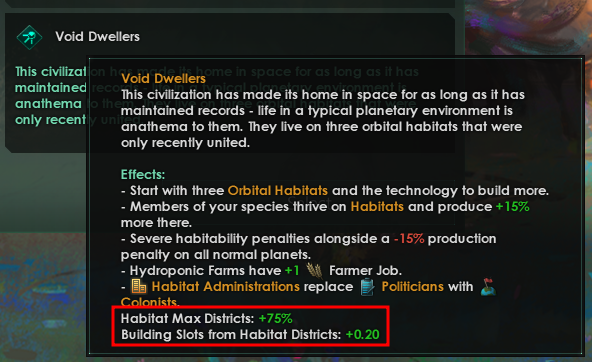 Support Habitats as Megastructures:
Support Habitats as Megastructures:The first iteration of these prototypes made use of Support Habitats as additional megastructures.


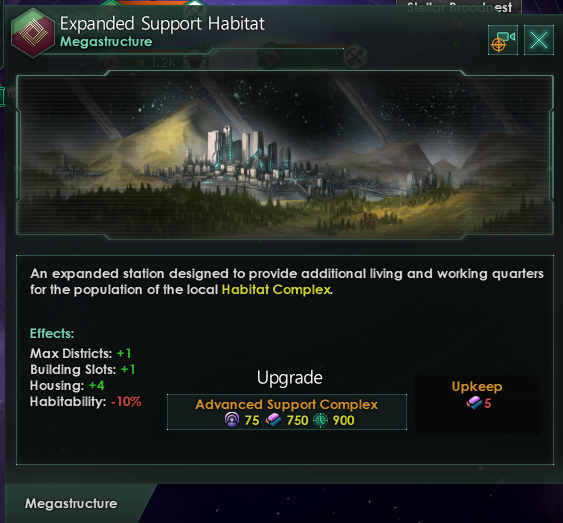

In this prototype, we had the maximum amount of each type of resource collection district (Energy, Minerals, Research) limited by the size of the deposits the habitats were constructed over, similar to how buildings for Strategic Resources are limited.
Support Habitats provided additional Districts, Building Slots, and Housing to the Habitat Central Complex, while reducing the Habitability (to reflect the civilian traffic between habitats) as they are upgraded. The final tier also allowed the Habitat Complex to use deposits on moons of their orbited planet.
On the surface, this prototype seems to satisfy our initial requirements and more:
- Conquering systems with Habitat-spam was easier due to there only being one functional “planet” per system.
- Constructing multiple Habitats per system felt rewarding as it upgraded your existing colony.
- The removal of multiple starting colonies removed one of our main concerns for allowing Hive-Minds to have access to the Void Dweller origin - their high pop growth rate due to excessive numbers of spawning pools in the early game. (Iggy had some thoughts on this that he’ll be mentioning in a future Dev Diary).
 A Void Dweller Habitat Complex.
A Void Dweller Habitat Complex.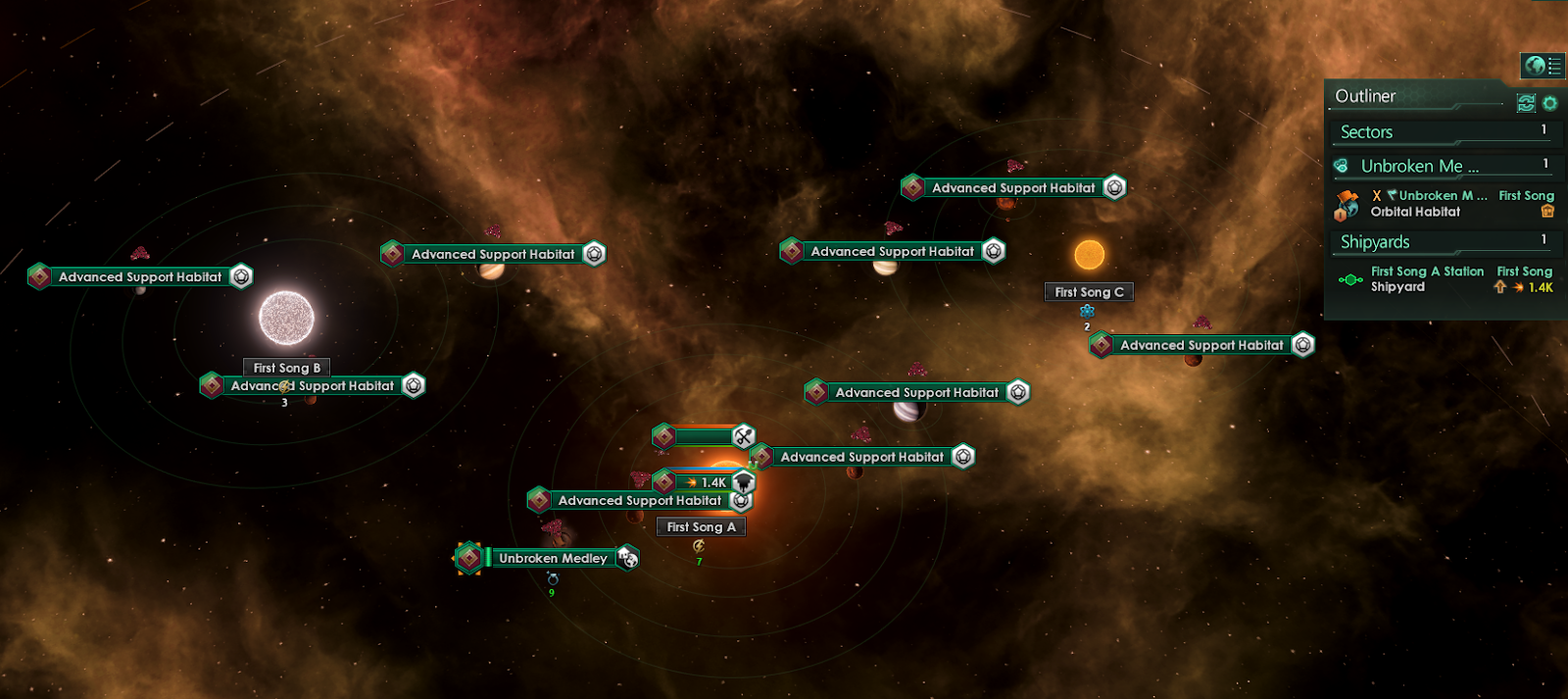 The rather cluttered system said Habitat Complex is in.
The rather cluttered system said Habitat Complex is in.However, the Support Habitats couldn’t be interacted with outside being upgraded, which felt like a major downside. Enemy ships would happily fly past and ignore the Support Habitats, they couldn’t be specialised or downgraded.
All things considered, this prototype showed that making habitats into a single logical planet spread across many entities in a solar system felt good, but megastructures were not the path forward.
Support Habitats as “Starbases”:Keep in mind that the numbers shown in the below screenshots are never intended to be the final values, but were used purely for testing purposes of how the systems felt to use and play with.
The below screenshots feature placeholder art and the default art for starbases, their buildings and modules.The second iteration of this prototype investigated treating Support Habitats as special Starbases (much like Orbital Rings).
In this prototype, the districts available to Habitat Central Complexes depend on the configuration of any Support Habitats in the same system. Thus construction of a Habitat Central Complex would automatically build a neighbouring Support Habitat in orbit of the same planet.
When built, a Support Habitat would start with a module that matches any deposits on the planet it orbits. Each
<District> Module on a Support Habitat, gives +3 Max Districts of that type to the Habitat Central Complex.
Upgrading the Support Habitats, still provides the same modifiers as shown in Megastructure Prototype. Additionally each tier of the Support Habitat allows construction of an additional Support Habitat module and the second and third tiers allow construction of a Support Habitat building.
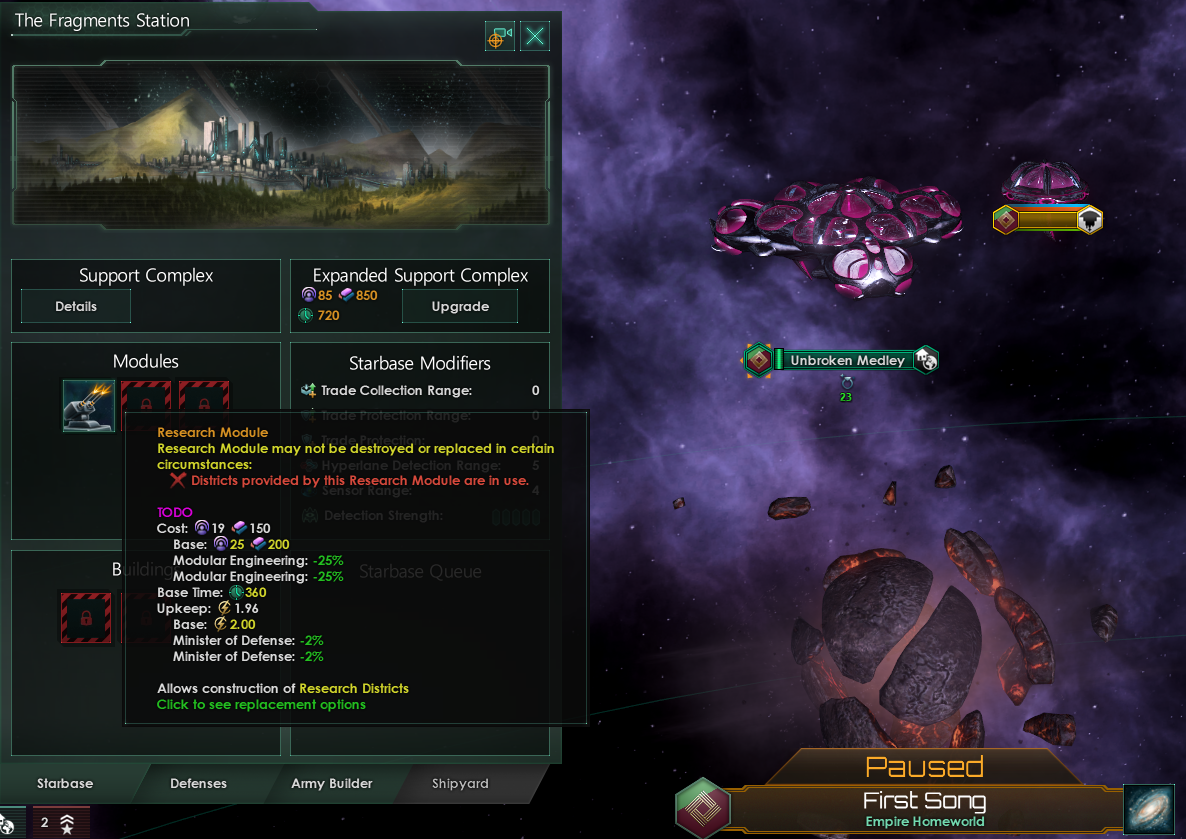 Expanded Support Complex v2 -- The starting Habitat Central Complex and its neighbouring Support Habitat for a Void Dweller empire.
Expanded Support Complex v2 -- The starting Habitat Central Complex and its neighbouring Support Habitat for a Void Dweller empire.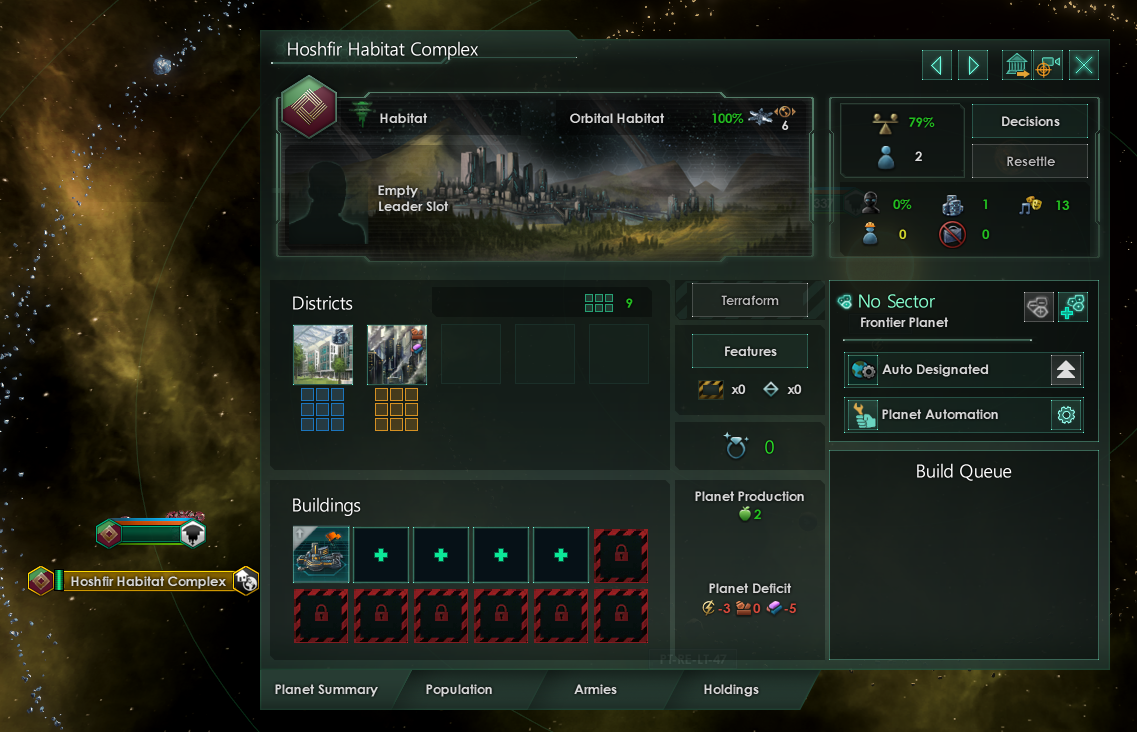 New Habitat Complex v2 -- A newly constructed Habitat Central Complex, completely unspecialised.
New Habitat Complex v2 -- A newly constructed Habitat Central Complex, completely unspecialised.Allowing the choice of which districts the Habitat Central Complex has access to via specialisation of the Support Habitats brings some interesting changes to how Habitat-dependent empires play.
Due to the nature of the prototype, the buildings for Support Habitats haven’t seen much investigation yet, but would likely include buildings much like those on an Orbital Ring, the lunar extraction support that Advanced Support Habitats experimented with in the Megastructure Prototype above and other such buildings.
 Research Habitat Complex, v3 or so? A Research Habitat Complex, using some of the district capacity to provide hydroponic districts.
Research Habitat Complex, v3 or so? A Research Habitat Complex, using some of the district capacity to provide hydroponic districts.Due to the nature of summer experiments, we can’t say if or when this prototype might make it into the live version of the game, but it’s something that we’re interested in exploring further.
…But the fourth one stayed up! Thanks, Alfray.
That variant listed achieved a lot of the goals we were looking for, but was cobbled together out of the scripting equivalent of sticks and twine as a quick and dirty implementation. It also required a lot of back and forth clicking that we really weren’t too fond of. So after that one burned down, fell over, and sank into the swamp, we came up with another iteration.
My feedback:
Simplify things.
The latest variant we’ve been playing with has been especially promising. In this one, we turned the “Starbase” style Support Habitats into single tiered “pre-specialized” units (renamed to “Orbitals” for UX purposes) rather than requiring Modules to be built on them - so you could build a Mining Orbital, Research Orbital, and so on.
This dramatically simplified the flow of building out Habitats while simultaneously improving the implementation.
 Pre-Specialized Research Orbital.
Pre-Specialized Research Orbital.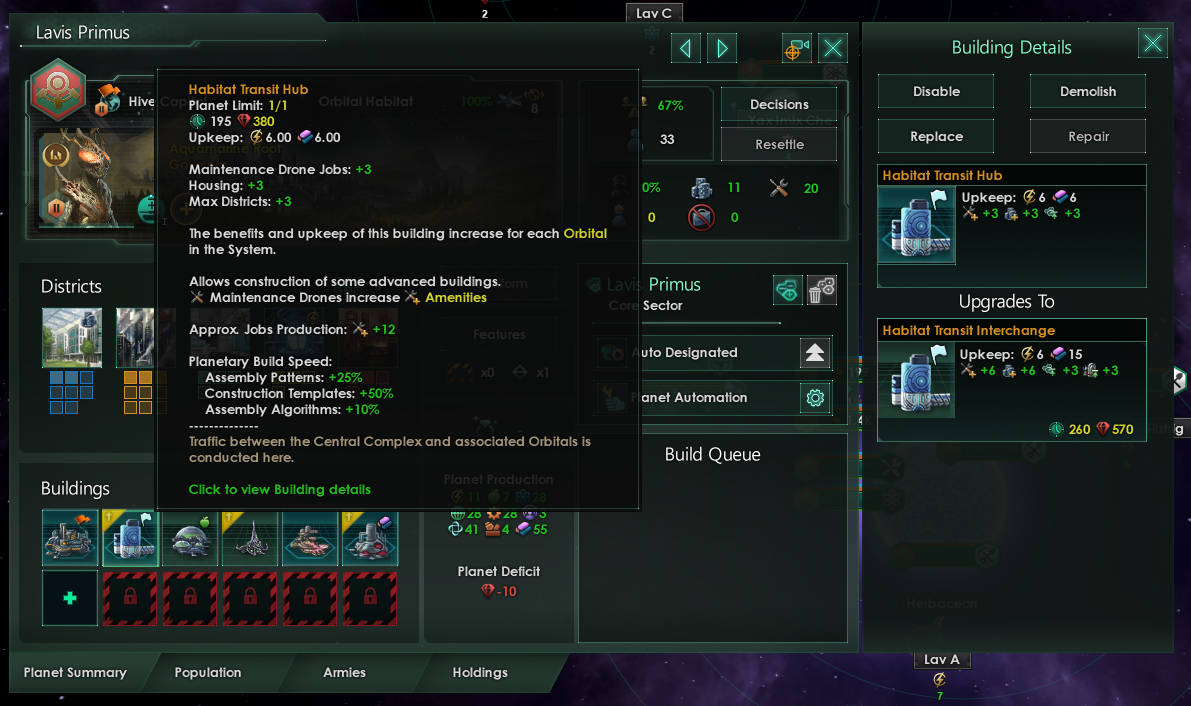 Habitat Transit Hub. Hey wait, Maintenance DRONES? Unique buildings on the primary habitat complex can increase the effects of the orbitals.
Habitat Transit Hub. Hey wait, Maintenance DRONES? Unique buildings on the primary habitat complex can increase the effects of the orbitals.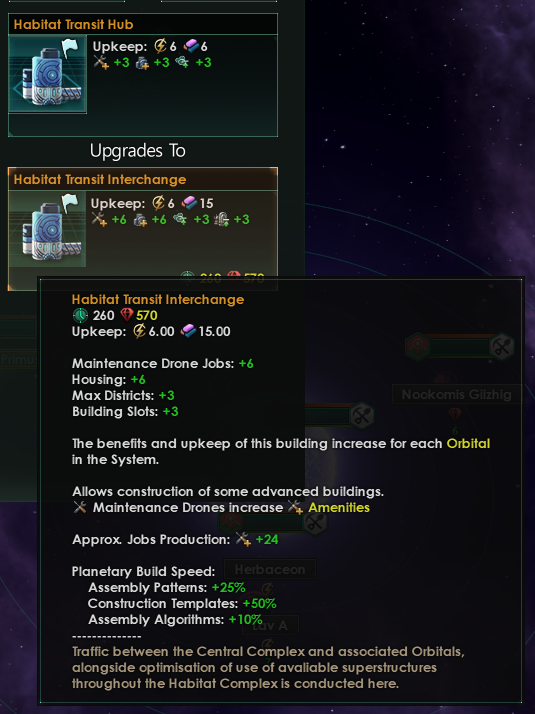 Upgraded Habitat Transit building.
Upgraded Habitat Transit building.We’re still doing some experimentation with this model, but so far we’re liking what we’re seeing. Technologies can add special Orbital types or buildings that can modify the primary Habitat Complex, and it’s very easy for us (or modders) to add new types.
We've been looking at jobs per districts too - the Complexes have different challenges from the older Habitat system, and further updated the Voidborne Ascension Perk. Void Dwellers will start with its effects (similar to how
Teachers of the Shroud empires effectively start with Mind over Matter).
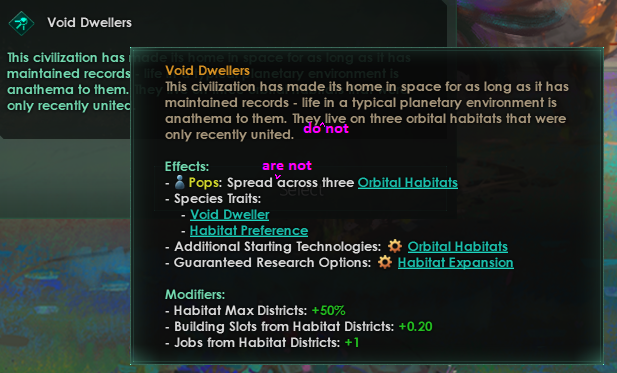
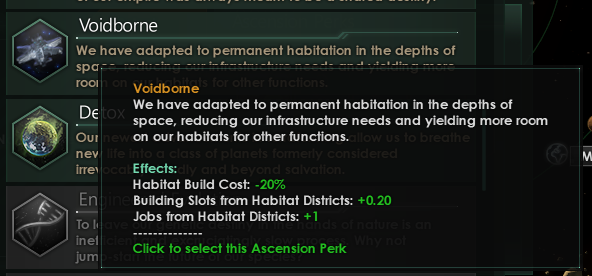 Void Dwellers get Habitat Build Cost reductions in Traditions.
Void Dwellers get Habitat Build Cost reductions in Traditions. What’s Next?
For now, I’d like to get some of your thoughts on what you’ve seen today, which we’ll bring into our internal design discussions. It would also be great to get feedback on whether you like this sort of diary, where we go through the overall process (including the failures).
Next week I'd like to talk about a Summer Experiment relating to leaders that didn’t pan out quite so well, and our plans on how to proceed with that.
See you then!















